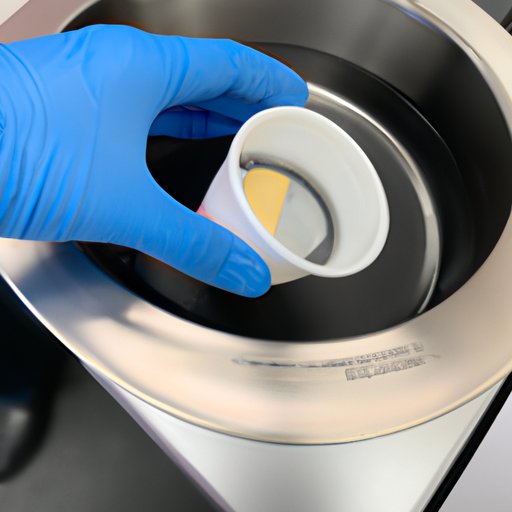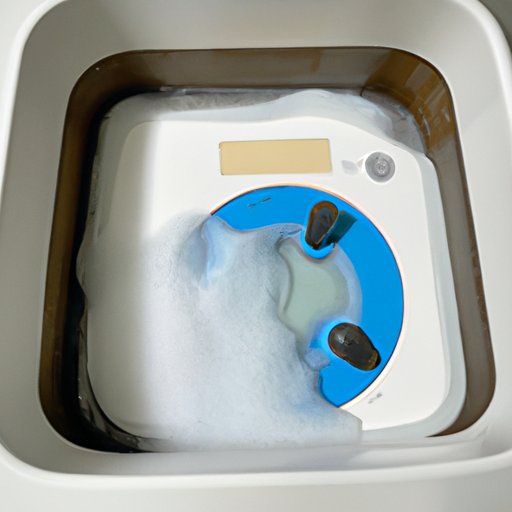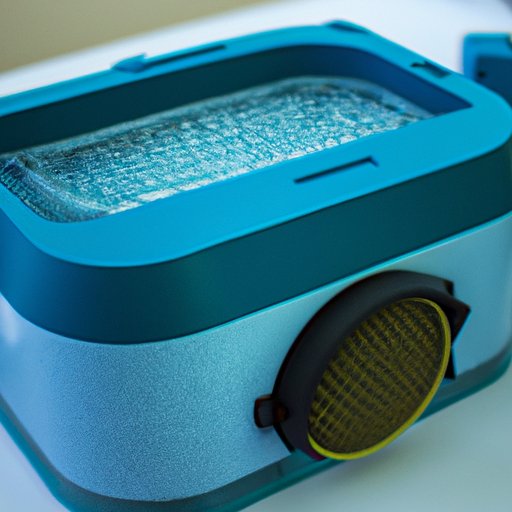Introduction
Ultrasonic cleaners are powerful tools that can be used to clean a wide variety of objects. From jewelry to medical instruments to car parts, these machines offer a safe and efficient way to remove dirt, grime, and other debris from items without damaging them. But how does an ultrasonic cleaner work? In this article, we’ll explore the science behind ultrasonic cleaning, how an ultrasonic cleaner operates, and the benefits of using one.

Exploring the Science Behind Ultrasonic Cleaning
Ultrasonic cleaning is based on a simple concept: sound waves create energy that agitates the water or cleaning solution around the object being cleaned, which helps to break up dirt and grime. This technique is often referred to as “cavitation.”
How Ultrasound Works
Ultrasound is sound waves with frequencies higher than those detectable by the human ear (20 kHz and above). These waves are generated when electricity is passed through a device called a transducer, which converts electrical energy into mechanical energy. The transducer then transmits the sound waves into a liquid medium such as water or a cleaning solution.
Physics of Ultrasonic Cleaning
When the ultrasound travels through the liquid medium, it creates areas of high and low pressure. These pressure fluctuations cause tiny bubbles, known as cavitation bubbles, to form and collapse rapidly on the surface of the object being cleaned. This process is referred to as “imploding cavitation.” As the bubbles collapse, they release a tremendous amount of energy that is capable of dislodging and removing stubborn dirt, grime, and other debris from the item.

An Overview of How an Ultrasonic Cleaner Operates
Now that we’ve explored the science behind ultrasonic cleaning, let’s take a look at how an ultrasonic cleaner operates. There are two main types of ultrasonic cleaners: immersion cleaners and tank cleaners. Immersion cleaners are small and portable, while tank cleaners are larger and more powerful. Both types use the same basic principles to clean items.
Types of Ultrasonic Cleaners
Immersion cleaners are designed to be used with a container of water or cleaning solution. The item to be cleaned is placed in the container, and the immersion cleaner is placed inside the container. Tank cleaners, on the other hand, are designed to be used with a large tank of water or cleaning solution. The item to be cleaned is placed directly into the tank, and the tank cleaner is installed inside the tank.
Components of an Ultrasonic Cleaner
Regardless of the type of ultrasonic cleaner, all models have the same basic components: a transducer, a generator, a timer, and a temperature control. The transducer converts the electrical energy from the generator into mechanical energy, which is then transmitted into the water or cleaning solution. The timer and temperature control are used to set the length of the cleaning cycle and the temperature of the cleaning solution.
The Cleaning Cycle
Once the ultrasonic cleaner is activated, the transducer begins generating sound waves. These sound waves create areas of high and low pressure in the cleaning solution, which causes the cavitation bubbles to form and collapse on the surface of the item being cleaned. This process removes dirt, grime, and other debris from the item. After the cleaning cycle is complete, the item is removed from the cleaning solution and dried.
A Basic Guide to Using an Ultrasonic Cleaner
Now that we’ve explored how an ultrasonic cleaner operates, let’s take a look at how to use one. Using an ultrasonic cleaner is easy, but there are a few steps you should follow to ensure the best results.
Preparing the Machine and Items to Be Cleaned
Before you begin, make sure the ultrasonic cleaner is filled with the appropriate amount of water or cleaning solution. You may also need to add a cleaning agent or detergent to the solution, depending on the type of item you’re cleaning. Next, place the item to be cleaned in the cleaning solution.
Setting the Time and Temperature
Once the item is in the cleaning solution, set the timer and temperature controls on the ultrasonic cleaner. Depending on the type of item you’re cleaning, you may need to adjust the settings to achieve the best results. Refer to the manufacturer’s instructions for specific guidelines.
Checking the Progress
Once the cleaning cycle has started, you can check the progress of the cleaning process. Some ultrasonic cleaners have a built-in window that allows you to see inside the tank as the cleaning cycle progresses. You can also open the lid of the tank to check the progress of the cleaning process.
Finishing the Cleaning Process
Once the cleaning cycle is complete, remove the item from the cleaning solution and rinse it with fresh water. Finally, dry the item thoroughly before storing or using it.

The Benefits of Using an Ultrasonic Cleaner
Using an ultrasonic cleaner offers a number of benefits, including increased efficiency, safer cleaning, and cost savings. Let’s take a closer look at each of these benefits.
Increased Efficiency
Ultrasonic cleaners are much more efficient than traditional cleaning methods. According to a study conducted by the University of California, Davis, using an ultrasonic cleaner can reduce cleaning time by up to 75%. This means that items can be cleaned much faster, saving both time and money.
Safer Cleaning
Ultrasonic cleaners are also safer than traditional cleaning methods. Since the cleaning process takes place in a closed tank, there is no risk of splashing or spilling chemicals. Additionally, many ultrasonic cleaners are designed to be used with non-toxic cleaning solutions, making them safer for both humans and the environment.
Cost Savings
Using an ultrasonic cleaner can also help save money in the long run. Since the cleaning process is so efficient, less cleaning solution is used, resulting in fewer costs for cleaning supplies. Additionally, since the cleaning process is so fast, less labor is required, resulting in additional cost savings.
Ultrasonic Cleaners: An In-Depth Look at How They Work
Now that we’ve explored the basics of how an ultrasonic cleaner operates, let’s take a deeper dive into the design and features of these machines. Understanding the design considerations, construction materials, operating modes, and additional features of an ultrasonic cleaner can help you determine which model is right for your needs.
Design Considerations
When selecting an ultrasonic cleaner, there are several design considerations to keep in mind. These include the size and shape of the machine, the type of transducer being used, the power output of the machine, and the material of the tank. All of these factors can affect the performance of the ultrasonic cleaner, so it’s important to select a model that meets your specific needs.
Construction Materials
The material of the tank is also an important consideration. The most common materials used for ultrasonic cleaner tanks are stainless steel, plastic, and aluminum. Each material has its own advantages and disadvantages, so it’s important to select the material that best suits your needs.
Operating Modes
Most ultrasonic cleaners have multiple operating modes that can be used for different types of cleaning. For example, some models feature a sweep mode, which slowly increases and decreases the frequency of the sound waves to create a more uniform cleaning effect. Other models feature a pulse mode, which alternates between high and low frequencies to create a more intense cleaning action.
Additional Features
Many ultrasonic cleaners also come with a number of additional features, such as timers and temperature sensors. Timers allow you to set the length of the cleaning cycle, while temperature sensors help you maintain an optimal cleaning temperature. Other features, such as built-in filters and automatic shutoff functions, can also help improve the performance of the machine.
Conclusion
Ultrasonic cleaners are powerful and efficient tools for cleaning a wide variety of items. By understanding the science behind ultrasonic cleaning and how an ultrasonic cleaner operates, you can better appreciate the benefits of using one. Additionally, learning about the design considerations, construction materials, operating modes, and additional features of an ultrasonic cleaner can help you find the right model for your needs.
In summary, ultrasonic cleaners offer increased efficiency, safer cleaning, and cost savings. Whether you’re looking for a small and portable machine or a large and powerful one, an ultrasonic cleaner can provide a safe and effective way to clean items quickly and easily.
(Note: Is this article not meeting your expectations? Do you have knowledge or insights to share? Unlock new opportunities and expand your reach by joining our authors team. Click Registration to join us and share your expertise with our readers.)
